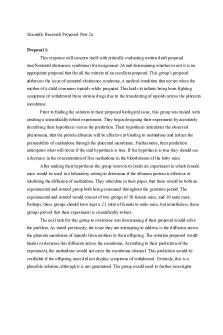The Hallmarks of scientific research PDF

| Title | The Hallmarks of scientific research |
|---|---|
| Author | Hamad Raza |
| Course | Research Tools and Techniques |
| Institution | COMSATS University Islamabad |
| Pages | 2 |
| File Size | 77.4 KB |
| File Type | |
| Total Downloads | 63 |
| Total Views | 172 |
Summary
Download The Hallmarks of scientific research PDF
Description
The Hallmarks of scientific research Following are the points of the Hallmarks scientific research: 1.
Purposiveness
2.
Rigor
3.
Testability
4.
Replicability
5.
Precision and confidence
6.
0bjectivity
7.
Generalizability
8.
Parsimony
Purposiveness The supervisor or the manager of an organization has started the research for a specific purpose. Focus on increasing employee commitment to the organization, as this will be beneficial in many ways. i.e increase performance level, decrease turnover and less absentees of employees.
Rigor Rigor suggests carefulness, honesty, and the degree of accuracy in research investigations. In the case of our example, let us say the manager of an organization asks 10 to 12 of its employees to suggest that how can we increase the level of commitment to it. It lacks rigor for the following reasons 1. The conclusions are incorrectly drawn because they are based on the opinions of a few employees whose views may not be representative of all employees.
2. The way in which framing and answer questions would lead to bias or incorrect answers. Testability The manager or researcher develops a hypothesis on how employee commitment can be improved, and then these can be tested by applying certain statistical tests on data
collected for the purpose. For instance, the researcher may hypothesize that those employees who observe greater opportunities for participation in decision making will have a higher level of commitment. Replicability We repeat the test of hypotheses again and gain for the better outcomes. We will place greater faith and trust in these findings and conclude if the same findings are based on data collected by other organizations using similar methods. To put it differently, hypothesis test results should be supported again and again when the same type of research is repeated in other similar cases. We will gain confidence in the scientific context of our research. In other words, our thoughts have been supported by chance, but they reflect the true state of affairs in people. Precision and confidence Precision refers to the closeness of the findings to “reality” based on a sample. In other words, precision reflects the degree of accuracy of the results on the basis of the sample, to what really exists in the universe. While Confidence refers to the probability that our estimations are correct. That is, it is not merely enough to be precise, but it is also important that we can confidently claim that 95% of our results will be true and there is only a 5% chance of our being wrong. This is also known as the confidence level. Objectivity The conclusions reached on the interpretation of the results of the data analysis should be objective, that is, they should be based on the facts of the findings based on actual data, not on our independent or emotional levels. For example, if the hypothesis is about organizational commitment, a lot of time and effort can be wasted in finding ways to create opportunities for staff participation in decision-making. Generalizability It refers to the scope of applicability of the research findings in one organizational setting to other settings. Obviously, the wider the range of applicability of the solutions generated by research, the more useful the research is to the users. Parsimony It can be introduced with a good understanding of the problem and the important factors that influence it. Such a good conceptual theoretical model can be realized through unstructured and structured interviews with the concerned people, and a thorough literature review of the previous research work in the particular problem area....
Similar Free PDFs

The Hallmarks of Cancer
- 5 Pages

Using The Scientific Literature
- 16 Pages

The Scientific Revolution
- 5 Pages

7 STEPS OF SCIENTIFIC METHOD
- 1 Pages
Popular Institutions
- Tinajero National High School - Annex
- Politeknik Caltex Riau
- Yokohama City University
- SGT University
- University of Al-Qadisiyah
- Divine Word College of Vigan
- Techniek College Rotterdam
- Universidade de Santiago
- Universiti Teknologi MARA Cawangan Johor Kampus Pasir Gudang
- Poltekkes Kemenkes Yogyakarta
- Baguio City National High School
- Colegio san marcos
- preparatoria uno
- Centro de Bachillerato Tecnológico Industrial y de Servicios No. 107
- Dalian Maritime University
- Quang Trung Secondary School
- Colegio Tecnológico en Informática
- Corporación Regional de Educación Superior
- Grupo CEDVA
- Dar Al Uloom University
- Centro de Estudios Preuniversitarios de la Universidad Nacional de Ingeniería
- 上智大学
- Aakash International School, Nuna Majara
- San Felipe Neri Catholic School
- Kang Chiao International School - New Taipei City
- Misamis Occidental National High School
- Institución Educativa Escuela Normal Juan Ladrilleros
- Kolehiyo ng Pantukan
- Batanes State College
- Instituto Continental
- Sekolah Menengah Kejuruan Kesehatan Kaltara (Tarakan)
- Colegio de La Inmaculada Concepcion - Cebu











